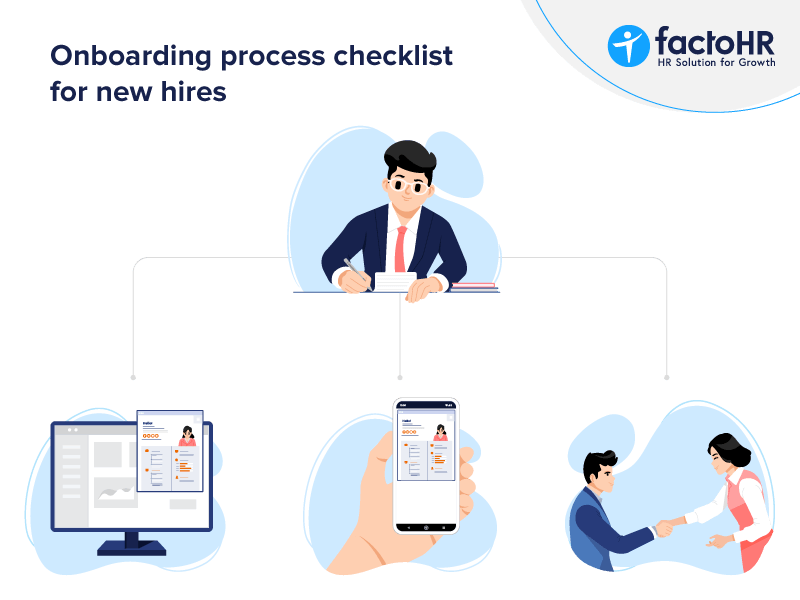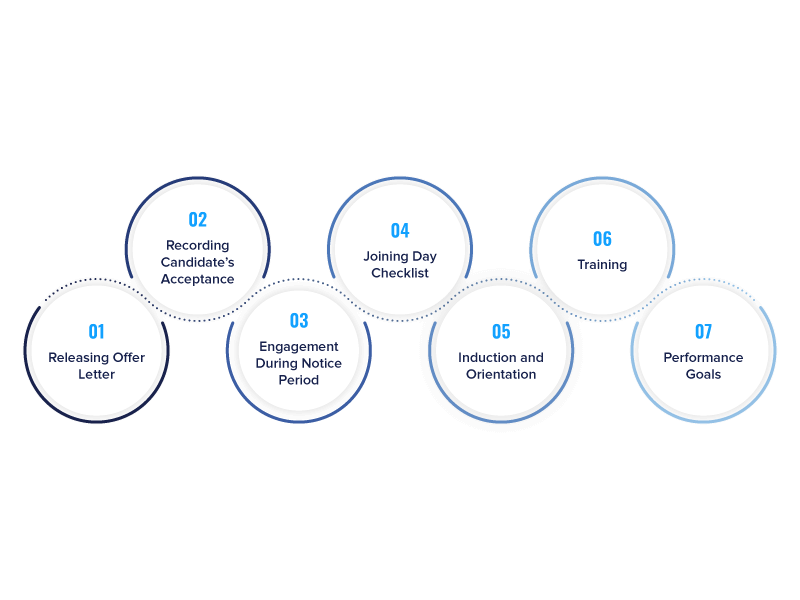Employee Onboarding Process : Onboarding Guide for HR Professionals

Table of Contents
In simple terms, employee onboarding means turning a hired candidate into an employee. The process is not so straightforward when you consider the amount of paperwork involved and the attention to detail required to make it the best experience for the candidate. It is all about making a good first impression and then presenting a consistently good culture of the organisation. This guide aims to cover all aspects of employee onboarding, and help organisations onboard their new employees effectively.
Onboarding Process Overview
HR professionals have a hard time finding the right candidate in the ever-shrinking talent pool. There are challenges at every step with the final challenge being ensuring that the offered candidate, in fact, turns up on the joining day. With many last-minute drop-outs, it becomes increasingly difficult for HR professionals to handhold the candidates till they complete all joining formalities.
Onboarding actually begins way before the joining formalities. Mature organisations consider the first interaction – an email or phone call – asking the candidate the convenient time for an interview; as the first step. The process is completed only when the candidate becomes a productive employee on the job. Every interaction between these two events comes under the onboarding process and influences the gradual impression a candidate forms about the organisation and its culture. Some experts suggest going further back to the job posting, to create the first impression of the organisation.

Benefits of Using Technology for Onboarding Employees
In the past, inducting new employees involved getting the candidate to fill out multiple forms and submit certificates & other documents for verification. An HR representative would then collect them and enter either the details into a spreadsheet and file all documents physically. The whole process used to be cumbersome without any agreed schedule on when the process would be completed. It translated to a whole lot of frustrating experiences even before the new employees met their superiors or peers.
With digitisation and automation, the modern onboarding process takes less time for paperwork leaving the new joiners to focus on getting themselves acquainted with the new job. A well-structured and robust software can help with this process immensely. HR professionals, on the other hand, can also focus on human aspects of ensuring continuous interaction with the new hire and the hiring managers.
The automated system thus:
- Helps reduce the stress on the HR department to onboard each and every new employee manually
- Empowers the new employees to enter their details without having to depend on their seniors
- Reduces the possibility of human errors
- Enables organisations to provide a consistent experience to all the new employees
- Encourages transparency which is sorely lacking when the process is carried out manually.
FactoHR’s employee onboarding software helps HR teams right from generating customised offer letters to entering new employee details and helping in post-onboarding activities, all the while giving the new employees a fantastic experience of the organisation.

Internal Transfers
In case of internal transfers, a certain amount of orientation is required to enable the employee to understand the new job role. This is usually preceded by HR professionals issuing relevant letters of authorisation announcing the new title and pay grade to the employee. Even these events can be managed via such software.
A Checklist for Efficient Onboarding in 2022

Here’s an onboarding checklist for creating a smooth joining process for your new hires.
Releasing Offer Letter
Sending the offer letter is one of the initial steps in the onboarding process. When a candidate is selected by the hiring manager after considering all the feedback obtained from the interviewers, a formal letter of offer is sent via email or post. The offer letter states the role, location of the job and compensation along with company policies and conditions of the offer.
This letter also asks the candidate to provide their acceptance before a certain date. The offer mail can also contain a request for a set of documents required for legal and regulatory purposes. The letter may also include links to onboarding forms that the candidates can fill at leisure.
Recording Candidate’s Acceptance
Once the candidate confirms their acceptance, HR needs to record that in their systems. This is useful for planning joining days and creating other schedules for further engagement with the candidate.
During this stage, it is advisable to schedule a telephone conversation to go over the contents of the offer letter and clarify any questions the candidate may have. This also provides an opportunity to congratulate and thank the candidate for their choice.
Engagement During Notice Period
Most lateral hires have to serve a notice period in their current organisations before they can join the new company. Current practice in India is two or three months of notice. It is normal for candidates to look for other opportunities in spite of having an offer in hand. Hence, this is a crucial period to keep the offered candidate “warm”.
What it means is that there has to be a regular engagement with the candidate to ensure that their acceptance decision does not change because of any other reasons. HR professionals should use this opportunity to build a cordial relationship emphasising how their decision is mutually beneficial.

Joining Day Checklist
Any change brings about a mix of emotions. Joining a new organisation is an important milestone and it is natural for most candidates to be nervous and anxious about their future in the new place. This is the time for HR professionals to step up and ensure the joining formalities are completed smoothly and as per schedule. This will help in reinforcing the trust as well as the good image of the organisation.
This can only happen if the HR manager is fully prepared with the checklist of things to do both for the new hire and for the organisation.
Below is a list of things to be accomplished on the day of joining:
- Ensure the salary account details are correctly captured, if the new hire already has one. Alternatively, create a new salary account with the organisation’s preferred bank.
- Provide the new joiner kit that may include all the assets required like laptop/desktop, phone, etc.
- Familiarise with the office layout and desk location
- Make introductions with the manager who can assign a buddy to help with settling in.
Induction and Orientation
Organisations conduct orientation sessions preferably at a location other than the workplace, with all the new hires for that month. Either a printed or soft version of the employee handbook is usually provided. These sessions familiarise new employees with the organisation’s mission, goals, rules, policies, ethics and culture that are described in the handbook. They also provide the new hires with the opportunity to ask questions and learn everything about the larger organisation.
It is important that at least one session is conducted where a senior colleague can interact with all the new hires and give them motivation and encouragement.
By end of this process, the new hires should have a fair understanding of
- What the organisation does
- What it believes in
- Who are the key decision-makers
- Organisation structure and where they fit in that big picture

Training
The HR manager needs to work with the new employee’s manager to schedule required training and identify all partners required to facilitate the training. Logistics like training rooms and other infrastructure need to be managed. This initial training and how the new hire progresses will give a sense of the quality of the selection process. It will also help in the next steps of the onboarding process too in terms of setting up performance goals.
There are two types of training imparted to new hires –
- Mandatory training: to ensure regulatory requirements are met. Examples of such training include anti-money laundering, gifts and anti-bribery policies. An employee handbook comes in very handy in this case.
- Skill training: Training required to perform the job. Examples of this training are technical training about the product or service. This type of training may include both classroom and/or online sessions along with on-the-job training. This is also an opportunity to hand over tasks and pending work from the exiting employee whom the new hire may be replacing.
Scheduling and maintaining training records has become easier with the help of software tools like Pendo.io, Whatfix, etc.
Performance Goals
The HR manager should facilitate a discussion between the new hire and their manager. This should be arranged after all the new hire training is complete.
The performance goals identified should be SMART – Simple, Measurable, Achievable, Relevant and Time-bound. In a continuous performance management model, the larger goals to be met by the year-end are broken down into several smaller SMART goals. One of the important aspects of this model is to find the earliest opportunity to course correct if there is any drop in performance. Usual reasons for low performance include a) misalignment between the employee and the manager in understanding the goal; b) a genuine requirement for training in a skill or new tool that the employee is not familiar with; and c) the attitude of the employee towards the job and/or genuine mismatch of skills to the ones needed for the role she is hired for. Each of the reasons calls for suitable remedial action. HR managers should actively engage and facilitate the right corrective action agreed upon by all parties.
Most organisations will have a cut-off date after which the new hires are not considered for the performance appraisal cycle. This is keeping in view the short period the employee is with the organisation and may not have the opportunity to fully contribute or be productive owing to induction and other training. Notwithstanding this, it is important to have a discussion to communicate the performance expectations.

What is new in 2022?
With the easing of COVID pandemic restrictions, all the onboarding activities can be completed face-to-face and on-premises while taking the required precautions. However, based on the learnings in the past couple of years, it is advisable to be prepared for web-based onboarding. Organisations have demonstrated that web-based processes can also be as effective as on-site ones. Companies went out of the way to deliver joiner kits to the new hires’ homes. HR professionals worked diligently throughout the pandemic period in ensuring there is no drop in quality. A large part of the credit also goes to the onboarding software that helped in automating quite a lot of paperwork.
Every organisation is different in terms of its line of business, work culture and mission. This checklist is a generic one that applies to most organisations. However, several other specific onboarding steps applicable to individual organisations will need to be included to make the checklist truly complete.
Grow your business with factoHR today
Focus on the significant decision-making tasks, transfer all your common repetitive HR tasks to factoHR and see the things falling into their place.

© 2025 Copyright factoHR


